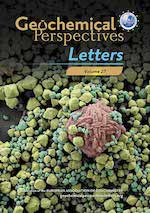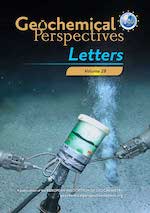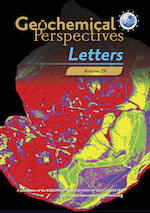Tight bounds on missing late veneer in early Archean peridotite from triple oxygen isotopes
Affiliations | Corresponding Author | Cite as | Funding information- Share this article





Article views:1,966Cumulative count of HTML views and PDF downloads.
- Download Citation
- Rights & Permissions
top
Abstract
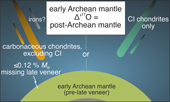
Figures
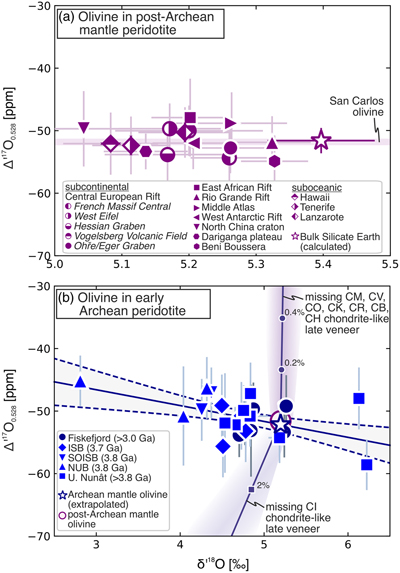 Figure 1 Plots of Δ′17O vs. δ′18O (±1 s.e.m.) of olivine from ultramafic rocks. (a) Olivine in peridotites that were erupted as xenoliths in Phanerozoic magmas and from the Beni Boussera massif, relative to the composition of San Carlos olivine (horizontal line, Δ′17O = −51.8 ppm; Supplementary Information S-2). The composition of the bulk silicate Earth (star) is calculated from the mean olivine compositions from this study ±1 s.d. and is based on −0.2 ‰ fractionation in δ18O and a θ value of 0.53 for fractionation between olivine and bulk peridotite. (b) Olivine from early Archean ultramafic enclaves with excess s-process Ru (Fischer-Gödde et al., 2020). The curve corresponds to a linear fit ±1 s.d. through the Archean peridotite data in δ17O versus δ18O space and is used to extrapolate the compositions of the samples, which were in part altered by fluid-rock reactions, to the Δ′17O of pristine olivine in the early Archean mantle with δ18O = 5.21 ‰ (star). Shadowed fields correspond to calculated olivine compositions if carbonaceous chondrites would be missing from the ultramafic enclaves, considering all carbonaceous chondrite meteorites for which data are available in the Meteoritical Bulletin Database as possible end member compositions for the late veneer (Table S-3). Curves are shown for missing late veneer with the average composition of CM, CV, CO, CK, CR, CH, CB chondrites and the average composition of CI chondrites, respectively, with the percentages of missing late veneer indicated relative to the mass of the Earth. | 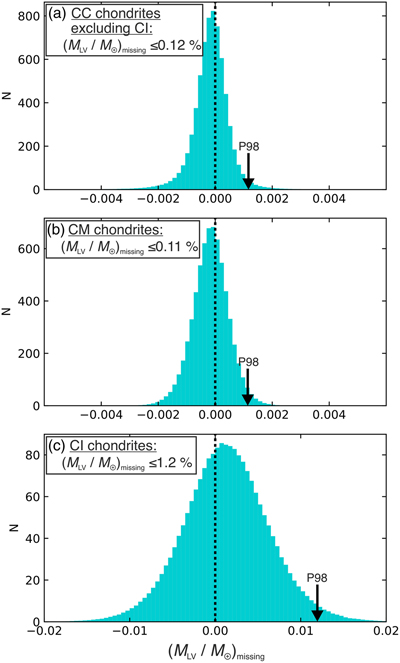 Figure 2 Missing late veneer from the Itsaq Gneiss Complex and Fiskefjord mantle relative to the mass of the Earth, (MLV/M⊕)missing, calculated from the data in this study and from available triple oxygen isotope data for carbonaceous chondrites (Monte Carlo simulation; 106 runs). End member compositions of the late veneer were sampled randomly for given chondrite groups from a compilation of all meteorite data that are available in the Meteoritical Bulletin Database (Table S-3). The δ18O value of the silicate Earth was considered to be 0.2 ‰ higher than olivine in mantle peridotite from this study, i.e. δ18OBSE = 5.41 ‰. The 97.72nd percentile (P98) of the outcomes are shown by arrows and are given in the panel headings as percentages; and are considered uppermost bounds for missing late veneer. Outcomes with negative values correspond to hypothetical scenarios in which the Itsaq Gneiss Complex and Fiskefjord mantle contain excess late veneer. Dotted lines show outcomes where (MLV/M⊕)missing = 0. (a) Missing carbonaceous chondrites, excluding CI chondrites. (b) Missing CM chondrites only. (c) Missing CI chondrites only. |
| Figure 1 | Figure 2 |
top
Introduction
Missing late veneer in early Archean mantle domains. Earth formed by the accretion of rocky materials in a protoplanetary disk. The final ∼0.5 % of these materials escaped metal-silicate equilibrium during core formation processes, and are commonly referred to as the late veneer (Walker, 2009
Walker, R.J. (2009) Highly siderophile elements in the Earth, Moon and Mars: Update and implications for planetary accretion and differentiation. Chemie der Erde 69, 101–125.
). The composition of these late accreted materials is interesting to study, because they possibly contributed a large portion of volatile elements and water to the Earth’s mass (Wang and Becker, 2013Wang, Z., Becker, H. (2013) Ratios of S, Se and Te in the silicate Earth require a volatile-rich late veneer. Nature 499, 328–331.
; Braukmüller et al., 2019Braukmüller, N., Wombacher, F., Funk, C., Münker, C. (2019) Earth’s volatile element depletion pattern inherited from a carbonaceous chondrite-like source. Nature Geoscience 12, 564–568.
).Based on platinum and tungsten isotope work, it was proposed that some Archean mantle domains did not incorporate the full amount of late veneer (e.g., Willbold et al., 2011
Willbold, M., Elliott, T., Moorbath, S. (2011) The tungsten isotopic composition of the Earth’s mantle before the terminal bombardment. Nature 477, 195–198.
; Creech et al., 2017Creech, J.B., Baker, J.A., Handler, M.R., Lorand, J.P., Storey, M., Wainwright, A.N., Luguet, A., Moynier, F., Bizzarro, M. (2017) Late accretion history of the terrestrial planets inferred from platinum stable isotopes. Geochemical Perspectives Letters 3, 94–104.
). Such mantle domains could then provide unique windows into the final stages of Earth’s accretion and its earliest evolution. An unambiguous pre-late veneer signal is present in ultramafic enclaves that are entrained in the Eoarchean Itsaq Gneiss Complex and Mesoarchean Fiskefjord region of southwest Greenland. These rocks show a uniform excess in s-process Ru nuclides compared to r-process Ru nuclides relative to the bulk silicate Earth (Fischer-Gödde et al., 2020Fischer-Gödde, M., Elfers, B.M., Münker, C., Szilas, K., Maier, W.D., Messling, N., Morishita, T., Van Kranendonk, M., Smithies, H. (2020) Ruthenium isotope vestige of Earth’s pre-late-veneer mantle preserved in Archaean rocks. Nature 579, 240–244.
). The excess s-process Ru in the ultramafic enclaves is best explained by a deficit in late accreted materials that carried a deficit in s-process Ru. Whereas both carbonaceous and non-carbonaceous chondrite groups carry deficits in s-process Ru, the s-process deficit is only sufficiently large in carbonaceous chondrite groups to potentially account for the observed s-process excess in the ultramafic enclaves, given the concentrations of platinum group elements in the Eoarchean mantle (Fischer-Gödde et al., 2020Fischer-Gödde, M., Elfers, B.M., Münker, C., Szilas, K., Maier, W.D., Messling, N., Morishita, T., Van Kranendonk, M., Smithies, H. (2020) Ruthenium isotope vestige of Earth’s pre-late-veneer mantle preserved in Archaean rocks. Nature 579, 240–244.
). This conclusion is important, because it would support a volatile-rich, carbonaceous chondrite-like late veneer, and therewith complement evidence from volatile chalcophile elements in the post-Archean mantle (Wang and Becker, 2013Wang, Z., Becker, H. (2013) Ratios of S, Se and Te in the silicate Earth require a volatile-rich late veneer. Nature 499, 328–331.
; Braukmüller et al., 2019Braukmüller, N., Wombacher, F., Funk, C., Münker, C. (2019) Earth’s volatile element depletion pattern inherited from a carbonaceous chondrite-like source. Nature Geoscience 12, 564–568.
; Varas-Reus et al., 2019Varas-Reus, M.I., König, S., Yierpan, A., Lorand, J.P., Schoenberg, R. (2019) Selenium isotopes as tracers of a late volatile contribution to Earth from the outer Solar System. Nature Geoscience 12, 779–782.
).Potential of studying triple oxygen isotope ratios. Oxygen stable isotope ratios (17O/16O, 18O/16O) are a unique tool for studying late accretion processes from a lithophile element perspective (Rumble et al., 2013
Rumble, D., Bowring, S., Iizuka, T., Komiya, T., Lepland, A., Rosing, M.T., Ueno, Y. (2013) The oxygen isotope composition of earth’s oldest rocks and evidence of a terrestrial magma ocean. Geochemistry, Geophysics, Geosystems 14, 1929–1939.
; Valley et al., 2014Valley, J.W., Cavosie, A.J., Ushikubo, T., Reinhard, D.A., Lawrence, D.F., Larson, D.J., Clifton, P.H., Kelly, T.F., Wilde, S.A., Moser, D.E., Spicuzza, M.J. (2014) Hadean age for a post-magma-ocean zircon confirmed by atom-probe tomography. Nature Geoscience 7, 219–223.
; Young et al., 2016Young, E.D., Kohl, I.E., Warren, P.H., Rubie, D.C., Jacobson, S.A., Morbidelli, A. (2016) Oxygen isotopic evidence for vigorous mixing during the Moon-forming giant impact. Science 351, 493–496.
; Reimink et al., 2018Reimink, J.R., Chacko, T., Carlson, R.W., Shirey, S.B., Liu, J., Stern, R.A., Bauer, A.M., Pearson, D.G., Heaman, L.M. (2018) Petrogenesis and tectonics of the Acasta Gneiss Complex derived from integrated petrology and 142Nd and 182W extinct nuclide-geochemistry. Earth and Planetary Science Letters 494, 12–22.
), because bulk asteroids in the Solar System show ∼6000 ppm variations in Δ′17O (Clayton, 1993Clayton, R.N. (1993) Oxygen isotopes in meteorites. Annual Review of Earth and Planetary Sciences 21, 115–149.
). This is large compared to the ∼5 ppm analytical resolution of state of the art laser fluorination techniques. Henceforth, we use a definition for Δ′17O with:Eq. 1

Carbonaceous chondrites have lower Δ′17O values than the silicate Earth, with only CI chondrites having similar but slightly higher Δ′17O and much higher δ18O values than the silicate Earth (Clayton, 1993
Clayton, R.N. (1993) Oxygen isotopes in meteorites. Annual Review of Earth and Planetary Sciences 21, 115–149.
). If the early Archean ultramafic enclaves from southwest Greenland would have been deprived of a late veneer component that resembles most carbonaceous chondrite types (CM, CV, CO, CK, CR, CH, CB chondrites), samples from the early Archean ultramafic enclaves would therefore be expected to have an elevated Δ′17O compared to the silicate Earth. Only if the ultramafic enclaves would be missing a late veneer component that resembles CI chondrites, would they have a similar or lower Δ′17O than the silicate Earth. In order to study mass and composition of the missing late veneer component from the early Archean ultramafic enclaves of southwest Greenland, we therefore compared their olivine Δ′17O values with olivine in post-Archean mantle peridotite.top
Samples and Methods
The suite of post-Archean mantle peridotite sample comprises 14 lherzolithic xenoliths that were erupted in Phanerozoic magmas from diverse geological settings, and 1 dunite sample from the Beni Boussera massif (Supplementary Information S-1). The ultramafic enclaves with s-process Ru excess (Fischer-Gödde et al., 2020
Fischer-Gödde, M., Elfers, B.M., Münker, C., Szilas, K., Maier, W.D., Messling, N., Morishita, T., Van Kranendonk, M., Smithies, H. (2020) Ruthenium isotope vestige of Earth’s pre-late-veneer mantle preserved in Archaean rocks. Nature 579, 240–244.
) that we studied are from two localities within the >3.7 Ga Isua supracrustal belt (ISB), one locality south of the Isua supracrustal belt (SOISB), the ∼3.8 Ga Narssaq ultramafic body (NUB), and the ∼3.8 Ga Ujaragssuit Nunât ultramafic body (Supplementary Information S-1). The early Archean ultramafic bodies were interpreted either as slivers of residual mantle peridotite, as metamorphosed cumulates from (ultra)mafic magmas, or, for one location, as an ultramafic layered intrusion. We also studied peridotite samples from the Fiskefjord region that are geologically related to the Mesoarchean Seqi peridotite body (Szilas et al., 2015Szilas, K., Kelemen, P.B., Bernstein, S. (2015) Peridotite enclaves hosted by Mesoarchaean TTG-suite orthogneisses in the Fiskefjord region of southern West Greenland. GeoResJ 7, 22–34.
), for which an excess in s-process Ru compared to the silicate Earth was also reported (Fischer-Gödde et al., 2020Fischer-Gödde, M., Elfers, B.M., Münker, C., Szilas, K., Maier, W.D., Messling, N., Morishita, T., Van Kranendonk, M., Smithies, H. (2020) Ruthenium isotope vestige of Earth’s pre-late-veneer mantle preserved in Archaean rocks. Nature 579, 240–244.
). Olivine samples were analysed for their triple oxygen isotope compositions (δ17O, δ18O) using laser assisted fluorination protocols (Supplementary Information S-2). All samples were analysed relative to San Carlos olivine, which is considered here to have a Δ′17O = −51.8 ppm relative to VSMOW.top
Results
Olivine δ18O values of the post-Archean mantle peridotite samples are on average δ18O = 5.21 ± 0.08 ‰ (1 s.d., n = 15), which is in good agreement with previous data for olivine in mantle peridotite (e.g., Mattey et al., 1994
Mattey, D., Lowry, D., Macpherson, C. (1994) Oxygen isotope composition of mantle peridotite. Earth and Planetary Science Letters 128, 231–241.
) (Table S-1). The post-Archean mantle peridotite samples have an average olivine Δ′17O value of −51.6 ± 2.1 ppm (1 s.d., n = 15; Fig. 1a), which is in line with data for mafic and ultramafic rocks from previous studies (Herwartz et al., 2014Herwartz, D., Pack, A., Friedrichs, B., Bischoff, A. (2014) Identification of the giant impactor Theia in lunar rocks. Science 344, 1146–1150.
; Greenwood et al., 2018Greenwood, R.C., Barrat, J.A., Miller, M.F., Anand, M., Dauphas, N., Franchi, I.A., Sillard, P., Starkey, N.A. (2018) Oxygen isotopic evidence for accretion of Earth’s water before a high-energy Moon-forming giant impact. Science Advances 4, 5928.
; Cano et al., 2020Cano, E.J., Sharp, Z.D., Shearer, C.K. (2020) Distinct oxygen isotope compositions of the Earth and Moon. Nature Geoscience 13, 270–274.
). No variations in olivine Δ′17O values were found for the post-Archean mantle peridotite samples. The peridotite samples from the Archean ultramafic enclaves in the Itsaq Gneiss Complex and Fiskefjord region show a much wider range in olivine δ18O values (δ18O = 2.8–6.2 ‰) (Table S-2). Olivine Δ′17O values of the early Archean ultramafic bodies are on average Δ′17O = −50.9 ± 3.2 ppm (1 s.d., n = 23), a value that is indistinguishable from the Δ′17O value of post-Archean mantle olivine. The early Archean peridotite samples show decreasing olivine Δ′17O values with increasing δ18O values (Fig. 1b).
Figure 1 Plots of Δ′17O vs. δ′18O (±1 s.e.m.) of olivine from ultramafic rocks. (a) Olivine in peridotites that were erupted as xenoliths in Phanerozoic magmas and from the Beni Boussera massif, relative to the composition of San Carlos olivine (horizontal line, Δ′17O = −51.8 ppm; Supplementary Information S-2). The composition of the bulk silicate Earth (star) is calculated from the mean olivine compositions from this study ±1 s.d. and is based on −0.2 ‰ fractionation in δ18O and a θ value of 0.53 for fractionation between olivine and bulk peridotite. (b) Olivine from early Archean ultramafic enclaves with excess s-process Ru (Fischer-Gödde et al., 2020
Fischer-Gödde, M., Elfers, B.M., Münker, C., Szilas, K., Maier, W.D., Messling, N., Morishita, T., Van Kranendonk, M., Smithies, H. (2020) Ruthenium isotope vestige of Earth’s pre-late-veneer mantle preserved in Archaean rocks. Nature 579, 240–244.
). The curve corresponds to a linear fit ±1 s.d. through the Archean peridotite data in δ17O versus δ18O space and is used to extrapolate the compositions of the samples, which were in part altered by fluid-rock reactions, to the Δ′17O of pristine olivine in the early Archean mantle with δ18O = 5.21 ‰ (star). Shadowed fields correspond to calculated olivine compositions if carbonaceous chondrites would be missing from the ultramafic enclaves, considering all carbonaceous chondrite meteorites for which data are available in the Meteoritical Bulletin Database as possible end member compositions for the late veneer (Table S-3). Curves are shown for missing late veneer with the average composition of CM, CV, CO, CK, CR, CH, CB chondrites and the average composition of CI chondrites, respectively, with the percentages of missing late veneer indicated relative to the mass of the Earth.top
Discussion
Effects of fluid-rock reactions. Olivine δ18O values of the early Archean peridotites predominantly deviate towards lower values compared to post-Archean mantle olivine. We reported similarly low and variable olivine δ18O values for a >2.7 Ga peridotite body that is entrained in the Kuummiut terrane in southeast Greenland, for which the low and variable δ18O values reflect the effects of fluid-rock reactions that were followed by dehydration of the peridotitic protoliths at high grade metamorphic conditions (Peters et al., 2020
Peters, S.T.M., Szilas, K., Sengupta, S., Kirkland, C.L., Garbe-Schönberg, D., Pack, A. (2020) >2.7 Ga metamorphic peridotites from southeast Greenland record the oxygen isotope composition of Archean seawater. Earth and Planetary Science Letters 544, 116331.
). Likewise, we suggest that the ultramafic enclaves in the Itsaq Gneiss Complex and Fiskefjord region experienced hydration and dehydration events during their metamorphic history that modified their primary olivine δ18O values, a process that is likely common for ultramafic rocks in Archean high grade metamorphic terranes (Nishio et al., 2019Nishio, I., Morishita, T., Szilas, K., Pearson, G., Tani, K.I., Tamura, A., Harigane, Y., Guotana, J.M. (2019) Titanian clinohumite-bearing peridotite from the ulamertoq ultramafic body in the 3.0 Ga akia terrane of southern west Greenland. Geosciences 9, 153.
) (Supplementary Information S-1). Fluid-rock reactions cannot only have shifted the δ18O values of the Archean peridotite samples, but may also have altered the Δ′17O values of the peridotite samples (e.g., Sengupta and Pack, 2018Sengupta, S., Pack, A. (2018) Triple oxygen isotope mass balance for the Earth’s oceans with application to Archean cherts. Chemical Geology 495, 18–26.
). In order to obtain the Δ′17O value of pristine olivine in the ultramafic rocks before they interacted with fluids, we extrapolated the measured Δ′17O values to the δ18O value of typical mantle olivine (this study; δ18O = 5.21 ‰) (Fig. 1b). The extrapolated Δ′17O value of pristine olivine in the early Archean mantle is −52.3 ± 1.7 ppm (1 s.d.); a value that is only 1.4 ppm lower than the average Δ′17O of the uncorrected data.Implications for missing late veneer. The suggested Δ′17O value of pristine olivine in the early Archean ultramafic rocks is indistinguishable from the mean Δ′17O value of olivine in post-Archean mantle peridotite (Fig. 1b). A pre-late veneer signal in the Archean ultramafic enclaves is thus not resolved with respect to oxygen isotopes. This conclusion corroborates earlier results from a laser fluorination study on the Acasta Gneiss Complex and Isua supracrustal belt (Rumble et al., 2013
Rumble, D., Bowring, S., Iizuka, T., Komiya, T., Lepland, A., Rosing, M.T., Ueno, Y. (2013) The oxygen isotope composition of earth’s oldest rocks and evidence of a terrestrial magma ocean. Geochemistry, Geophysics, Geosystems 14, 1929–1939.
), and lower resolution SIMS data for the Jack Hills zircons, as well as zircons from the Acasta Gneiss Complex and (Valley et al., 2014Valley, J.W., Cavosie, A.J., Ushikubo, T., Reinhard, D.A., Lawrence, D.F., Larson, D.J., Clifton, P.H., Kelly, T.F., Wilde, S.A., Moser, D.E., Spicuzza, M.J. (2014) Hadean age for a post-magma-ocean zircon confirmed by atom-probe tomography. Nature Geoscience 7, 219–223.
; Reimink et al., 2018Reimink, J.R., Chacko, T., Carlson, R.W., Shirey, S.B., Liu, J., Stern, R.A., Bauer, A.M., Pearson, D.G., Heaman, L.M. (2018) Petrogenesis and tectonics of the Acasta Gneiss Complex derived from integrated petrology and 142Nd and 182W extinct nuclide-geochemistry. Earth and Planetary Science Letters 494, 12–22.
). Using the new data, we calculated the uppermost likely limits for missing late veneer from the Itsaq Gneiss Complex and Fiskefjord mantle, assuming the compositions of carbonaceous chondrite groups as the missing components (c.f. Fischer-Gödde et al., 2020Fischer-Gödde, M., Elfers, B.M., Münker, C., Szilas, K., Maier, W.D., Messling, N., Morishita, T., Van Kranendonk, M., Smithies, H. (2020) Ruthenium isotope vestige of Earth’s pre-late-veneer mantle preserved in Archaean rocks. Nature 579, 240–244.
). In general, and by definition, the compositions of the mantle before the late veneer (hereafter ‘pre-late veneer mantle’; PLVM), the bulk silicate Earth and the late veneer plot on a mixing line in δ17O versus δ18O space. The slope m and intercept i of this mixing line are given by the δ17O and δ18O values of the bulk silicate Earth and the composition of the late veneer. In δ′17O versus δ′18O space, the composition of the pre-late veneer mantle also plots on a line with slope 0.528 and intercept Δ′17O that equals the value for the pre-late veneer mantle. The point of intersection of the two relations in δ′17O versus δ′18O space is given by:Eq. 2

and can be approximated with the Newton-Raphson method. The intersection δ values then allow determining the oxygen atom fraction of missing late veneer from the pre-late veneer mantle (Supplementary Information S-4).
Based on Equation 2 we modelled possible masses of missing late veneer if carbonaceous chondrite groups would be missing from the Itsaq Gneiss Complex and Fiskefjord mantle, using a Monte Carlo approach (Fig. 2). In each Monte Carlo run, the end member composition of the late veneer was selected by randomly sampling a meteorite composition from the carbonaceous chondrite groups of interest, i.e. each meteorite specimen from a given selection of carbonaceous chondrites was considered equally likely to represent a possible end member composition of the late veneer (Table S-3). We adopted concentrations in the mixing calculations of 46.5 wt. % oxygen in carbonaceous chondrites and 44.33 wt. % oxygen in the terrestrial mantle (Palme and O’Neill, 2003
Palme, H., O’Neill, H. (2003) 2.01 – Cosmochemical estimates of mantle composition. In: Holland, H.D., Turekian, K.K. (Eds.) Treatise on Geochemistry. First Edition, Elsevier, Oxford. 1–38.
). In the simulations, the Δ′17O values for the bulk silicate Earth and the pre-late veneer mantle were sampled from normally distributed populations that are described by the mean values and standard deviations for post-Archean mantle peridotite and the extrapolated Δ′17O value for pristine olivine in early Archean peridotite from this study, respectively. We consider the 97.72nd percentile of the outcomes of the simulations as the uppermost likely values for the missing late veneer. These uppermost values correspond to a missing late veneer component relative to the Earth’s mass (M⊕) of ≤0.12 % M⊕ if the missing component would resemble CM, CV, CO, CK, CR, CH, CB, but not CI chondrites (Fig. 2a); ≤0.11 % M⊕ if the missing component would resemble only CM chondrites (Fig. 2b); and ≤1.2 % M⊕ if the missing component would resemble CI chondrites (Fig. 2c).
Figure 2 Missing late veneer from the Itsaq Gneiss Complex and Fiskefjord mantle relative to the mass of the Earth, (MLV/M⊕)missing, calculated from the data in this study and from available triple oxygen isotope data for carbonaceous chondrites (Monte Carlo simulation; 106 runs). End member compositions of the late veneer were sampled randomly for given chondrite groups from a compilation of all meteorite data that are available in the Meteoritical Bulletin Database (Table S-3). The δ18O value of the silicate Earth was considered to be 0.2 ‰ higher than olivine in mantle peridotite from this study, i.e. δ18OBSE = 5.41 ‰. The 97.72nd percentile (P98) of the outcomes are shown by arrows and are given in the panel headings as percentages; and are considered uppermost bounds for missing late veneer. Outcomes with negative values correspond to hypothetical scenarios in which the Itsaq Gneiss Complex and Fiskefjord mantle contain excess late veneer. Dotted lines show outcomes where (MLV/M⊕)missing = 0. (a) Missing carbonaceous chondrites, excluding CI chondrites. (b) Missing CM chondrites only. (c) Missing CI chondrites only.
Our modelling results have implications for the materials that comprised Earth’s late veneer. Fischer-Gödde et al. (2020)
Fischer-Gödde, M., Elfers, B.M., Münker, C., Szilas, K., Maier, W.D., Messling, N., Morishita, T., Van Kranendonk, M., Smithies, H. (2020) Ruthenium isotope vestige of Earth’s pre-late-veneer mantle preserved in Archaean rocks. Nature 579, 240–244.
estimated based on their Ru isotope data that a late veneer component of up to 0.3 % M⊕ of carbonaceous chondrite-like materials could be missing from the Itsaq Gneiss Complex and Fiskefjord mantle, and favoured CM chondrites as the missing component. The oxygen isotope data, in contrast, imply that only a much smaller component of carbonaceous chondrites (≤0.12 % M⊕) can possibly be missing from the early Archean ultramafic enclaves with respect to oxygen, unless this component comprises CI chondrites. We propose two end member scenarios that best reconcile the triple oxygen isotope data with the available Ru isotope data. In one end member scenario, the missing late veneer component indeed resembles CM chondrites with the equivalent mass of ≤0.11 % M⊕ (Fig. 2b). This scenario implies that the early Archean mantle had incorporated more than ca. >86 % late veneer with respect to lithophile elements, which agrees with some estimates from the concentrations of highly siderophile elements in the early Archean mantle (van de Löcht et al., 2018van de Löcht, J., Hoffmann, J.E., Li, C., Wang, Z., Becker, H., Rosing, M.T., Kleinschrodt, R., Münker, C. (2018) Earth’s oldest mantle peridotites show entire record of late accretion. Geology 46, 199–202.
), but not with others (Dale et al., 2017Dale, C.W., Kruijer, T.S., Burton, K.W. (2017) Highly siderophile element and 182W evidence for a partial late veneer in the source of 3.8 Ga rocks from Isua, Greenland. Earth and Planetary Science Letters 458, 394–404.
). The missing CM chondrite-like component was possibly complemented by a missing component of carbonaceous group iron meteorite-like materials, e.g., materials similar to the IID and IVA irons that have comparable Ru isotope compositions compared to carbonaceous chondrites (Fischer-Gödde and Kleine, 2017Fischer-Gödde, M., Kleine, T. (2017) Ruthenium isotopic evidence for an inner Solar System origin of the late veneer. Nature 541, 525–527.
) and high Ru concentrations, but are deficient in O. This scenario is also consistent with highly siderophile element concentrations and 187Os/188Os ratios in lunar impact rocks and in the upper mantle (Fischer-Gödde and Becker, 2012Fischer-Gödde, M., Becker, H. (2012) Osmium isotope and highly siderophile element constraints on ages and nature of meteoritic components in ancient lunar impact rocks. Geochimica et Cosmochimica Acta 77, 135–156.
). In the second end member scenario, the missing late veneer component resembles the composition of CI chondrites (Fig. 2c). This scenario is feasible only if the s-process Ru deficit in CI chondrites is greater than was considered in the modelling by Fischer-Gödde et al. (2020)Fischer-Gödde, M., Elfers, B.M., Münker, C., Szilas, K., Maier, W.D., Messling, N., Morishita, T., Van Kranendonk, M., Smithies, H. (2020) Ruthenium isotope vestige of Earth’s pre-late-veneer mantle preserved in Archaean rocks. Nature 579, 240–244.
. We consider this a reasonable suggestion, because the Ru isotope composition of CI chondrites is constrained at present by a single meteorite specimen only, whereas other carbonaceous chondrite groups show internal Ru isotope variations (Fischer-Gödde and Kleine, 2017Fischer-Gödde, M., Kleine, T. (2017) Ruthenium isotopic evidence for an inner Solar System origin of the late veneer. Nature 541, 525–527.
).The discussion of our data thus far concerns the mass and composition of a late veneer component that can possibly be missing from the early Archean mantle. It can be assumed instead that the early Archean mantle was deficient in 40 % late accreted materials (Dale et al., 2017
Dale, C.W., Kruijer, T.S., Burton, K.W. (2017) Highly siderophile element and 182W evidence for a partial late veneer in the source of 3.8 Ga rocks from Isua, Greenland. Earth and Planetary Science Letters 458, 394–404.
). Following this line of logic, the triple oxygen isotope data imply a maximum late accreted mass of ≤0.3 % M⊕ for CM, CV, CO, CK, CR, CH, CB chondrites; and ≤3 % M⊕ CI chondrites. In conjunction with the absolute concentrations of highly siderophile elements in the post-Archean mantle, this conclusion would imply that the late veneer contained abundant CI-like materials; a scenario that agrees well with volatile element patterns (Braukmüller et al., 2019Braukmüller, N., Wombacher, F., Funk, C., Münker, C. (2019) Earth’s volatile element depletion pattern inherited from a carbonaceous chondrite-like source. Nature Geoscience 12, 564–568.
) and the Se isotope composition of the post-Archean mantle (Varas-Reus et al., 2019Varas-Reus, M.I., König, S., Yierpan, A., Lorand, J.P., Schoenberg, R. (2019) Selenium isotopes as tracers of a late volatile contribution to Earth from the outer Solar System. Nature Geoscience 12, 779–782.
).top
Acknowledgements
We thank Jesse Reimink and an anonymous reviewer for constructive feedback on the manuscript, and Helen Williams for editorial handling. Some of the post-Archean peridotite samples were collected in the field by Gerhard Wörner, Tsegaye Abebe Adhana, Qunke Xia, and Yuliya Kochergina. KS acknowledges grant CF18-0090 from the Carlsberg Foundation for field work; CM and CMA acknowledge funding by DFG project Mu 1406/18 within SPP 1833.
Editor: Helen Williams
top
References
Braukmüller, N., Wombacher, F., Funk, C., Münker, C. (2019) Earth’s volatile element depletion pattern inherited from a carbonaceous chondrite-like source. Nature Geoscience 12, 564–568.
 Show in context
Show in contextIn conjunction with the absolute concentrations of highly siderophile elements in the post-Archean mantle, this conclusion would imply that the late veneer contained abundant CI-like materials; a scenario that agrees well with volatile element patterns (Braukmüller et al., 2019) and the Se isotope composition of the post-Archean mantle (Varas-Reus et al., 2019).
View in article
This conclusion is important, because it would support a volatile-rich, carbonaceous chondrite-like late veneer, and therewith complement evidence from volatile chalcophile elements in the post-Archean mantle (Wang and Becker, 2013; Braukmüller et al., 2019; Varas-Reus et al., 2019).
View in article
Cano, E.J., Sharp, Z.D., Shearer, C.K. (2020) Distinct oxygen isotope compositions of the Earth and Moon. Nature Geoscience 13, 270–274.
 Show in context
Show in contextThe post-Archean mantle peridotite samples have an average olivine Δ′17O value of −51.6 ± 2.1 ppm (1 s.d., n = 15; Fig. 1a), which is in line with data for mafic and ultramafic rocks from previous studies (Herwartz et al., 2014; Greenwood et al., 2018; Cano et al., 2020).
View in article
Clayton, R.N. (1993) Oxygen isotopes in meteorites. Annual Review of Earth and Planetary Sciences 21, 115–149.
 Show in context
Show in contextCarbonaceous chondrites have lower Δ′17O values than the silicate Earth, with only CI chondrites having similar but slightly higher Δ′17O and much higher δ18O values than the silicate Earth (Clayton, 1993).
View in article
Oxygen stable isotope ratios (17O/16O, 18O/16O) are a unique tool for studying late accretion processes from a lithophile element perspective (Rumble et al., 2013; Valley et al., 2014; Young et al., 2016; Reimink et al., 2018), because bulk asteroids in the Solar System show ∼6000 ppm variations in Δ′17O (Clayton, 1993).
View in article
Creech, J.B., Baker, J.A., Handler, M.R., Lorand, J.P., Storey, M., Wainwright, A.N., Luguet, A., Moynier, F., Bizzarro, M. (2017) Late accretion history of the terrestrial planets inferred from platinum stable isotopes. Geochemical Perspectives Letters 3, 94–104.
 Show in context
Show in contextBased on platinum and tungsten isotope work, it was proposed that some Archean mantle domains did not incorporate the full amount of late veneer (e.g., Willbold et al., 2011; Creech et al., 2017).
View in article
Dale, C.W., Kruijer, T.S., Burton, K.W. (2017) Highly siderophile element and 182W evidence for a partial late veneer in the source of 3.8 Ga rocks from Isua, Greenland. Earth and Planetary Science Letters 458, 394–404.
 Show in context
Show in contextIt can be assumed instead that the early Archean mantle was deficient in 40 % late accreted materials (Dale et al., 2017).
View in article
>86 % late veneer with respect to lithophile elements, which agrees with some estimates from the concentrations of highly siderophile elements in the early Archean mantle (van de Löcht et al., 2018), but not with others (Dale et al., 2017).
View in article
Fischer-Gödde, M., Becker, H. (2012) Osmium isotope and highly siderophile element constraints on ages and nature of meteoritic components in ancient lunar impact rocks. Geochimica et Cosmochimica Acta 77, 135–156.
 Show in context
Show in contextThis scenario is also consistent with highly siderophile element concentrations and 187Os/188Os ratios in lunar impact rocks and in the upper mantle (Fischer-Gödde and Becker, 2012).
View in article
Fischer-Gödde, M., Kleine, T. (2017) Ruthenium isotopic evidence for an inner Solar System origin of the late veneer. Nature 541, 525–527.
 Show in context
Show in contextThe missing CM chondrite-like component was possibly complemented by a missing component of carbonaceous group iron meteorite-like materials, e.g., materials similar to the IID and IVA irons that have comparable Ru isotope compositions compared to carbonaceous chondrites (Fischer-Gödde and Kleine, 2017) and high Ru concentrations, but are deficient in O.
View in article
We consider this a reasonable suggestion, because the Ru isotope composition of CI chondrites is constrained at present by a single meteorite specimen only, whereas other carbonaceous chondrite groups show internal Ru isotope variations (Fischer-Gödde and Kleine, 2017).
View in article
Fischer-Gödde, M., Elfers, B.M., Münker, C., Szilas, K., Maier, W.D., Messling, N., Morishita, T., Van Kranendonk, M., Smithies, H. (2020) Ruthenium isotope vestige of Earth’s pre-late-veneer mantle preserved in Archaean rocks. Nature 579, 240–244.
 Show in context
Show in contextThese rocks show a uniform excess in s-process Ru nuclides compared to r-process Ru nuclides relative to the bulk silicate Earth (Fischer-Gödde et al., 2020).
View in article
Whereas both carbonaceous and non-carbonaceous chondrite groups carry deficits in s-process Ru, the s-process deficit is only sufficiently large in carbonaceous chondrite groups to potentially account for the observed s-process excess in the ultramafic enclaves, given the concentrations of platinum group elements in the Eoarchean mantle (Fischer-Gödde et al., 2020).
View in article
The ultramafic enclaves with s-process Ru excess (Fischer-Gödde et al., 2020) that we studied are from two localities within the >3.7 Ga Isua supracrustal belt (ISB), one locality south of the Isua supracrustal belt (SOISB), the ∼3.8 Ga Narssaq ultramafic body (NUB), and the ∼3.8 Ga Ujaragssuit Nunât ultramafic body (Supplementary Information S-1).
View in article
(b) Olivine from early Archean ultramafic enclaves with excess s-process Ru (Fischer-Gödde et al., 2020).
View in article
Using the new data, we calculated the uppermost likely limits for missing late veneer from the Itsaq Gneiss Complex and Fiskefjord mantle, assuming the compositions of carbonaceous chondrite groups as the missing components (c.f. Fischer-Gödde et al., 2020).
View in article
Fischer-Gödde et al. (2020) estimated based on their Ru isotope data that a late veneer component of up to 0.3 % M⊕ of carbonaceous chondrite-like materials could be missing from the Itsaq Gneiss Complex and Fiskefjord mantle, and favoured CM chondrites as the missing component.
View in article
This scenario is feasible only if the s-process Ru deficit in CI chondrites is greater than was considered in the modelling by Fischer-Gödde et al. (2020).
View in article
We also studied peridotite samples from the Fiskefjord region that are geologically related to the Mesoarchean Seqi peridotite body (Szilas et al., 2015), for which an excess in s-process Ru compared to the silicate Earth was also reported (Fischer-Gödde et al., 2020).
View in article
Greenwood, R.C., Barrat, J.A., Miller, M.F., Anand, M., Dauphas, N., Franchi, I.A., Sillard, P., Starkey, N.A. (2018) Oxygen isotopic evidence for accretion of Earth’s water before a high-energy Moon-forming giant impact. Science Advances 4, 5928.
 Show in context
Show in contextThe post-Archean mantle peridotite samples have an average olivine Δ′17O value of −51.6 ± 2.1 ppm (1 s.d., n = 15; Fig. 1a), which is in line with data for mafic and ultramafic rocks from previous studies (Herwartz et al., 2014; Greenwood et al., 2018; Cano et al., 2020).
View in article
Herwartz, D., Pack, A., Friedrichs, B., Bischoff, A. (2014) Identification of the giant impactor Theia in lunar rocks. Science 344, 1146–1150.
 Show in context
Show in contextThe post-Archean mantle peridotite samples have an average olivine Δ′17O value of −51.6 ± 2.1 ppm (1 s.d., n = 15; Fig. 1a), which is in line with data for mafic and ultramafic rocks from previous studies (Herwartz et al., 2014; Greenwood et al., 2018; Cano et al., 2020).
View in article
Mattey, D., Lowry, D., Macpherson, C. (1994) Oxygen isotope composition of mantle peridotite. Earth and Planetary Science Letters 128, 231–241.
 Show in context
Show in contextOlivine δ18O values of the post-Archean mantle peridotite samples are on average δ18O = 5.21 ± 0.08 ‰ (1 s.d., n = 15), which is in good agreement with previous data for olivine in mantle peridotite (e.g., Mattey et al., 1994) (Table S-1).
View in article
Nishio, I., Morishita, T., Szilas, K., Pearson, G., Tani, K.I., Tamura, A., Harigane, Y., Guotana, J.M. (2019) Titanian clinohumite-bearing peridotite from the ulamertoq ultramafic body in the 3.0 Ga akia terrane of southern west Greenland. Geosciences 9, 153.
 Show in context
Show in contextLikewise, we suggest that the ultramafic enclaves in the Itsaq Gneiss Complex and Fiskefjord region experienced hydration and dehydration events during their metamorphic history that modified their primary olivine δ18O values, a process that is likely common for ultramafic rocks in Archean high grade metamorphic terranes (Nishio et al., 2019) (Supplementary Information S-1).
View in article
Palme, H., O’Neill, H. (2003) 2.01 – Cosmochemical estimates of mantle composition. In: Holland, H.D., Turekian, K.K. (Eds.) Treatise on Geochemistry. First Edition, Elsevier, Oxford. 1–38.
 Show in context
Show in contextWe adopted concentrations in the mixing calculations of 46.5 wt. % oxygen in carbonaceous chondrites and 44.33 wt. % oxygen in the terrestrial mantle (Palme and O’Neill, 2003).
View in article
Peters, S.T.M., Szilas, K., Sengupta, S., Kirkland, C.L., Garbe-Schönberg, D., Pack, A. (2020) >2.7 Ga metamorphic peridotites from southeast Greenland record the oxygen isotope composition of Archean seawater. Earth and Planetary Science Letters 544, 116331.
 Show in context
Show in contextWe reported similarly low and variable olivine δ18O values for a >2.7 Ga peridotite body that is entrained in the Kuummiut terrane in southeast Greenland, for which the low and variable δ18O values reflect the effects of fluid-rock reactions that were followed by dehydration of the peridotitic protoliths at high grade metamorphic conditions (Peters et al., 2020).
View in article
Reimink, J.R., Chacko, T., Carlson, R.W., Shirey, S.B., Liu, J., Stern, R.A., Bauer, A.M., Pearson, D.G., Heaman, L.M. (2018) Petrogenesis and tectonics of the Acasta Gneiss Complex derived from integrated petrology and 142Nd and 182W extinct nuclide-geochemistry. Earth and Planetary Science Letters 494, 12–22.
 Show in context
Show in contextThis conclusion corroborates earlier results from a laser fluorination study on the Acasta Gneiss Complex and Isua supracrustal belt (Rumble et al., 2013), and lower resolution SIMS data for the Jack Hills zircons, as well as zircons from the Acasta Gneiss Complex and (Valley et al., 2014; Reimink et al., 2018).
View in article
Oxygen stable isotope ratios (17O/16O, 18O/16O) are a unique tool for studying late accretion processes from a lithophile element perspective (Rumble et al., 2013; Valley et al., 2014; Young et al., 2016; Reimink et al., 2018), because bulk asteroids in the Solar System show ∼6000 ppm variations in Δ′17O (Clayton, 1993).
View in article
Rumble, D., Bowring, S., Iizuka, T., Komiya, T., Lepland, A., Rosing, M.T., Ueno, Y. (2013) The oxygen isotope composition of earth’s oldest rocks and evidence of a terrestrial magma ocean. Geochemistry, Geophysics, Geosystems 14, 1929–1939.
 Show in context
Show in contextOxygen stable isotope ratios (17O/16O, 18O/16O) are a unique tool for studying late accretion processes from a lithophile element perspective (Rumble et al., 2013; Valley et al., 2014; Young et al., 2016; Reimink et al., 2018), because bulk asteroids in the Solar System show ∼6000 ppm variations in Δ′17O (Clayton, 1993).
View in article
This conclusion corroborates earlier results from a laser fluorination study on the Acasta Gneiss Complex and Isua supracrustal belt (Rumble et al., 2013), and lower resolution SIMS data for the Jack Hills zircons, as well as zircons from the Acasta Gneiss Complex and (Valley et al., 2014; Reimink et al., 2018).
View in article
Sengupta, S., Pack, A. (2018) Triple oxygen isotope mass balance for the Earth’s oceans with application to Archean cherts. Chemical Geology 495, 18–26.
 Show in context
Show in contextFluid-rock reactions cannot only have shifted the δ18O values of the Archean peridotite samples, but may also have altered the Δ′17O values of the peridotite samples (e.g., Sengupta and Pack, 2018).
View in article
Szilas, K., Kelemen, P.B., Bernstein, S. (2015) Peridotite enclaves hosted by Mesoarchaean TTG-suite orthogneisses in the Fiskefjord region of southern West Greenland. GeoResJ 7, 22–34.
 Show in context
Show in contextWe also studied peridotite samples from the Fiskefjord region that are geologically related to the Mesoarchean Seqi peridotite body (Szilas et al., 2015), for which an excess in s-process Ru compared to the silicate Earth was also reported (Fischer-Gödde et al., 2020).
View in article
Valley, J.W., Cavosie, A.J., Ushikubo, T., Reinhard, D.A., Lawrence, D.F., Larson, D.J., Clifton, P.H., Kelly, T.F., Wilde, S.A., Moser, D.E., Spicuzza, M.J. (2014) Hadean age for a post-magma-ocean zircon confirmed by atom-probe tomography. Nature Geoscience 7, 219–223.
 Show in context
Show in contextOxygen stable isotope ratios (17O/16O, 18O/16O) are a unique tool for studying late accretion processes from a lithophile element perspective (Rumble et al., 2013; Valley et al., 2014; Young et al., 2016; Reimink et al., 2018), because bulk asteroids in the Solar System show ∼6000 ppm variations in Δ′17O (Clayton, 1993).
View in article
This conclusion corroborates earlier results from a laser fluorination study on the Acasta Gneiss Complex and Isua supracrustal belt (Rumble et al., 2013), and lower resolution SIMS data for the Jack Hills zircons, as well as zircons from the Acasta Gneiss Complex and (Valley et al., 2014; Reimink et al., 2018).
View in article
van de Löcht, J., Hoffmann, J.E., Li, C., Wang, Z., Becker, H., Rosing, M.T., Kleinschrodt, R., Münker, C. (2018) Earth’s oldest mantle peridotites show entire record of late accretion. Geology 46, 199–202.
 Show in context
Show in context>86 % late veneer with respect to lithophile elements, which agrees with some estimates from the concentrations of highly siderophile elements in the early Archean mantle (van de Löcht et al., 2018), but not with others (Dale et al., 2017).
View in article
Varas-Reus, M.I., König, S., Yierpan, A., Lorand, J.P., Schoenberg, R. (2019) Selenium isotopes as tracers of a late volatile contribution to Earth from the outer Solar System. Nature Geoscience 12, 779–782.
 Show in context
Show in contextIn conjunction with the absolute concentrations of highly siderophile elements in the post-Archean mantle, this conclusion would imply that the late veneer contained abundant CI-like materials; a scenario that agrees well with volatile element patterns (Braukmüller et al., 2019) and the Se isotope composition of the post-Archean mantle (Varas-Reus et al., 2019).
View in article
This conclusion is important, because it would support a volatile-rich, carbonaceous chondrite-like late veneer, and therewith complement evidence from volatile chalcophile elements in the post-Archean mantle (Wang and Becker, 2013; Braukmüller et al., 2019; Varas-Reus et al., 2019).
View in article
Walker, R.J. (2009) Highly siderophile elements in the Earth, Moon and Mars: Update and implications for planetary accretion and differentiation. Chemie der Erde 69, 101–125.
 Show in context
Show in contextThe final ∼0.5 % of these materials escaped metal-silicate equilibrium during core formation processes, and are commonly referred to as the late veneer (Walker, 2009).
View in article
Wang, Z., Becker, H. (2013) Ratios of S, Se and Te in the silicate Earth require a volatile-rich late veneer. Nature 499, 328–331.
 Show in context
Show in contextThe composition of these late accreted materials is interesting to study, because they possibly contributed a large portion of volatile elements and water to the Earth’s mass (Wang and Becker, 2013; Braukmüller et al., 2019).
View in article
This conclusion is important, because it would support a volatile-rich, carbonaceous chondrite-like late veneer, and therewith complement evidence from volatile chalcophile elements in the post-Archean mantle (Wang and Becker, 2013; Braukmüller et al., 2019; Varas-Reus et al., 2019).
View in article
Willbold, M., Elliott, T., Moorbath, S. (2011) The tungsten isotopic composition of the Earth’s mantle before the terminal bombardment. Nature 477, 195–198.
 Show in context
Show in contextBased on platinum and tungsten isotope work, it was proposed that some Archean mantle domains did not incorporate the full amount of late veneer (e.g., Willbold et al., 2011; Creech et al., 2017).
View in article
Young, E.D., Kohl, I.E., Warren, P.H., Rubie, D.C., Jacobson, S.A., Morbidelli, A. (2016) Oxygen isotopic evidence for vigorous mixing during the Moon-forming giant impact. Science 351, 493–496.
 Show in context
Show in contextOxygen stable isotope ratios (17O/16O, 18O/16O) are a unique tool for studying late accretion processes from a lithophile element perspective (Rumble et al., 2013; Valley et al., 2014; Young et al., 2016; Reimink et al., 2018), because bulk asteroids in the Solar System show ∼6000 ppm variations in Δ′17O (Clayton, 1993).
View in article
top
Supplementary Information
The Supplementary Information includes:
- S-1. Sample Suite
- S-2. Analytical Methods
- S-3. Determining the Bulk Silicate Earth Δ′17O Value
- S-4. Mass Balance Calculations for Missing Late Veneer
- Figure S-1
- Tables S-1 to S-3
- Supplementary Information References
Download Table S-3 (Excel).
Download the Supplementary Information (PDF).
Figures
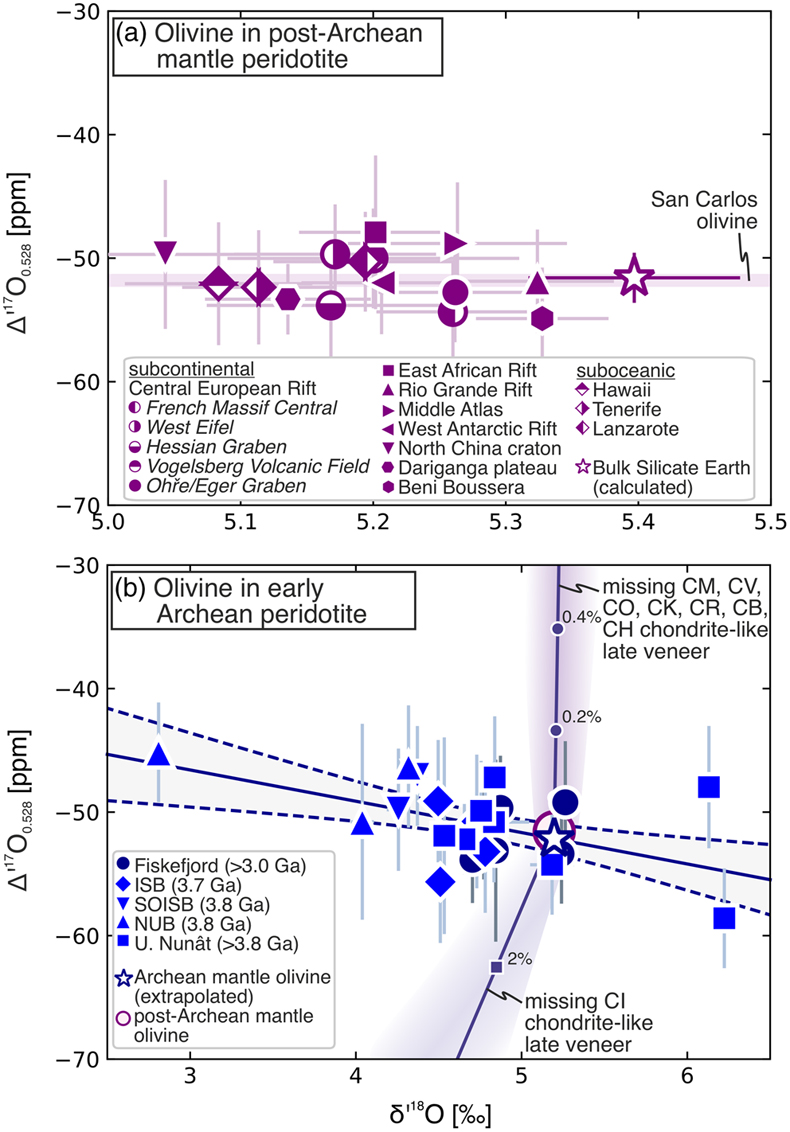
Figure 1 Plots of Δ′17O vs. δ′18O (±1 s.e.m.) of olivine from ultramafic rocks. (a) Olivine in peridotites that were erupted as xenoliths in Phanerozoic magmas and from the Beni Boussera massif, relative to the composition of San Carlos olivine (horizontal line, Δ′17O = −51.8 ppm; Supplementary Information S-2). The composition of the bulk silicate Earth (star) is calculated from the mean olivine compositions from this study ±1 s.d. and is based on −0.2 ‰ fractionation in δ18O and a θ value of 0.53 for fractionation between olivine and bulk peridotite. (b) Olivine from early Archean ultramafic enclaves with excess s-process Ru (Fischer-Gödde et al., 2020
Fischer-Gödde, M., Elfers, B.M., Münker, C., Szilas, K., Maier, W.D., Messling, N., Morishita, T., Van Kranendonk, M., Smithies, H. (2020) Ruthenium isotope vestige of Earth’s pre-late-veneer mantle preserved in Archaean rocks. Nature 579, 240–244.
). The curve corresponds to a linear fit ±1 s.d. through the Archean peridotite data in δ17O versus δ18O space and is used to extrapolate the compositions of the samples, which were in part altered by fluid-rock reactions, to the Δ′17O of pristine olivine in the early Archean mantle with δ18O = 5.21 ‰ (star). Shadowed fields correspond to calculated olivine compositions if carbonaceous chondrites would be missing from the ultramafic enclaves, considering all carbonaceous chondrite meteorites for which data are available in the Meteoritical Bulletin Database as possible end member compositions for the late veneer (Table S-3). Curves are shown for missing late veneer with the average composition of CM, CV, CO, CK, CR, CH, CB chondrites and the average composition of CI chondrites, respectively, with the percentages of missing late veneer indicated relative to the mass of the Earth.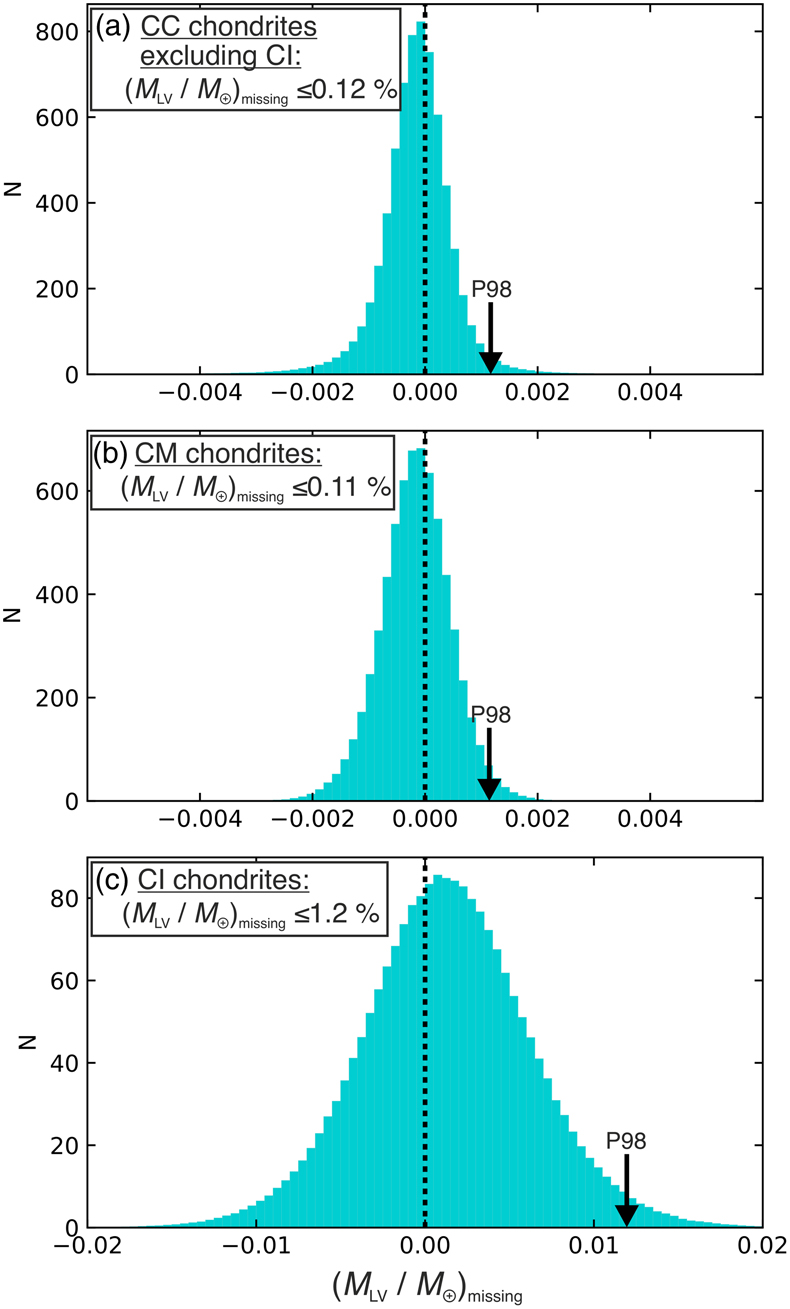
Figure 2 Missing late veneer from the Itsaq Gneiss Complex and Fiskefjord mantle relative to the mass of the Earth, (MLV/M⊕)missing, calculated from the data in this study and from available triple oxygen isotope data for carbonaceous chondrites (Monte Carlo simulation; 106 runs). End member compositions of the late veneer were sampled randomly for given chondrite groups from a compilation of all meteorite data that are available in the Meteoritical Bulletin Database (Table S-3). The δ18O value of the silicate Earth was considered to be 0.2 ‰ higher than olivine in mantle peridotite from this study, i.e. δ18OBSE = 5.41 ‰. The 97.72nd percentile (P98) of the outcomes are shown by arrows and are given in the panel headings as percentages; and are considered uppermost bounds for missing late veneer. Outcomes with negative values correspond to hypothetical scenarios in which the Itsaq Gneiss Complex and Fiskefjord mantle contain excess late veneer. Dotted lines show outcomes where (MLV/M⊕)missing = 0. (a) Missing carbonaceous chondrites, excluding CI chondrites. (b) Missing CM chondrites only. (c) Missing CI chondrites only.


